| This is reputed to be one of the best Pioneer museums in the west.
Given that every small town seems to have one, this certainly outclasses
anything we've seen so far. And it's free. Although not the first item we
encountered I think we should start with a bust of Brigham Young. Not that I
think the Pioneers brought this, but it seems appropriate. Actually the only
other bust was of the lady who founded the museum and collected many of the
artifacts.
The building which houses it was built in the style of a theatre with
partial upper floors like balconies. It has since been extended. | 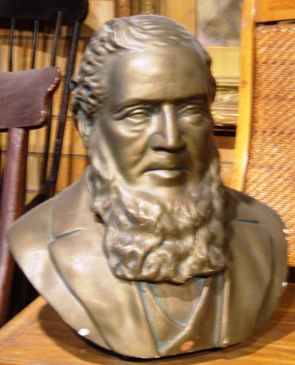 |
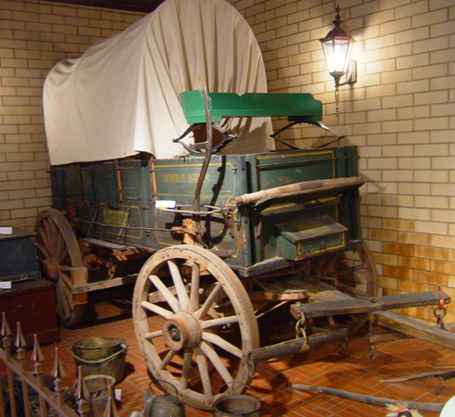 |
The extension holds some of the larger exhibits such as
this covered wagon. Many pioneers travelled in wagons like this, although
many others walked and pulled their belongings, and children, in handcarts
the 1350 miles from Illinois. |
| There are some original garments such as this buckskin jacket and
the suede coat worn by a Pony Express rider. This was explained to us by a
lovely old lady (must have been 90) who insisted on guiding us around to
begin with. The rider, she explained, was her grandfather!. | 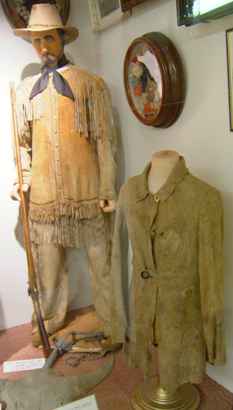 |
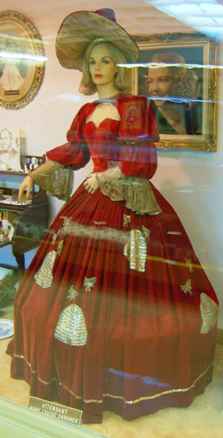 |
I always had the impression that the Pioneers were poor as well as
persecuted, but now I'm not so sure that was the case. Certainly they could
afford some fine things, some of which were shipped out to them from as far
away as Paris (easier after
the railroad arrived in the 1870s). There were also some unexpected things
such as the early accordians and other musical instruments. The lines are
reflections in the glass protecting it from sticky fingers. |
| There were over 20 pianos and organs each of which came on a
covered wagon and had a story behind it. Some were left along the wayside
buried in Buffalo skins and recovered later. Other articles were items sold
or left by other pioneers as they passed through on their way to California. |  |
 |
Other items were more home grown but with tremendous skill and artistry, like this table made a few years after arrival from the boards of Brigham
Young's wagon. The cabinetry is exquisite. There was another marquetry table
made from over 10,000 pieces of wood of 250 different kinds of trees. |
| But everywhere were the photographs of the early pioneers
captured by the still infant mechanism of photography. This particular
side room contained the pictures of and instruments used by all the doctors and midwives, who were
virtually all women because the men were busy producing the means of their
daily survival. In amongst all the names were a lot of Scandinavian
ones whereas we had been led to believe the Mormons were originally of
English and Scottish extraction. One wonders what led these two groups to
embrace a common religious doctrine, especially one which had only been
created some 17 years before. |
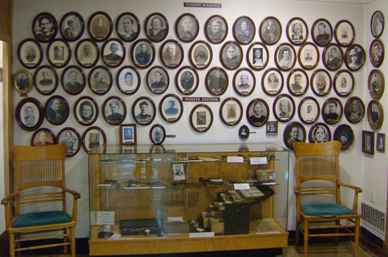 |
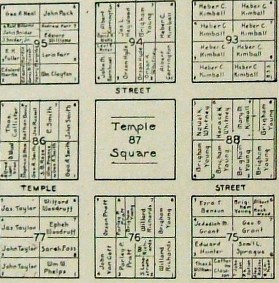 |
The museum actually houses quite a lot of documents as well as the 'stories'
attached to all the items on display. I found
this chart of the original plot assignments quite fascinating. Why for
example did Heber C Kimball get eight plots (and his relatives a lot more)
whilst Brigham Young only got five? And who decided who got the choice plots
nearest the temple? Either nobody knew or they weren't telling. I've never
quite understood the logic behind some of the genealogy work the church
does, but the genealogy of this lot could be quite interesting historically.
And why was the temple placed here and not on the significantly more
prominent site a few blocks to the north? We may never know the answers
but Mary Kimball's plot now houses the office block whilst Heber Kimball's
is a car park. Justice?? |
| Lastly we found this magnificent horse drawn fire engine although I doubt
this came on across the plains on a covered wagon. But every piece has a
story. This was built in 1902 at a cost of $8900 and restored in 1996 at a
cost of $125,000. It was in service until 1972 and was called 'Roosevelt' | 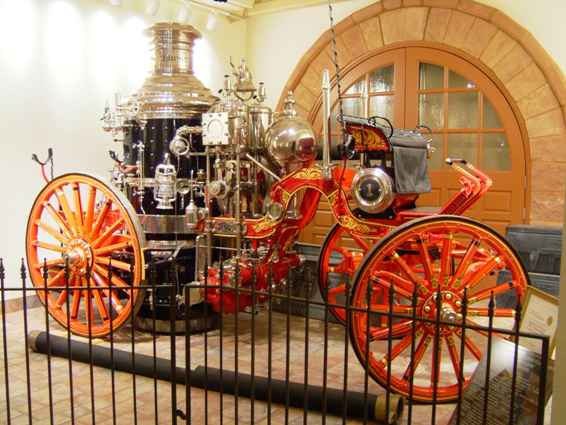 |
|